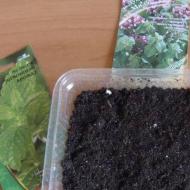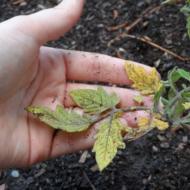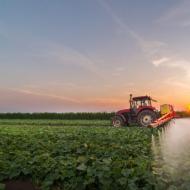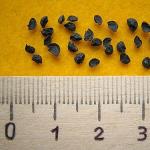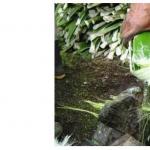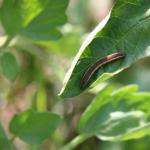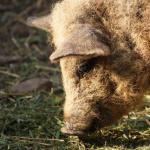
How to feed cucumbers for a good harvest. How to feed cucumbers in the ground
Kira Stoletova
In the middle of summer, cucumbers usually enter the phase of active fruiting. During this period, plants do not need abundant watering, but proper feeding of cucumbers in July, on the contrary, is necessary.

Why you need top dressing in July
It is very important to remove ripe cucumbers in time in July and regularly feed the cucumber bush to get a plentiful and high-quality harvest. If the plant does not have enough nutrition, then yellowing of the leaves is observed, the absence of young ovaries. Proper feeding of cucumbers in July creates favorable conditions for plant development and increases yield by 15-20%.
Fertilizer Application Methods
Fertilizers can be applied in two ways:
- root (watering),
- foliar (spraying).
Root top dressing is best used in hot, dry summers. Foliar are appropriate in cold summer. It is recommended to spend them either in the evening and early in the morning, or in cloudy weather at any time. For better digestibility of mineral fertilizers as a result of spraying, pour the leaves with clean water after the procedure.
How to feed cucumbers in July
One of the most necessary components for cucumbers during active fruiting is nitrogen. With a shortage of this element (can be determined by thinned lashes, small yellow leaves and narrowed at the tip, light cucumbers), it is advisable to use the following fertilizers:
- mullein solution 1:10 (1 liter under the root),
- 2% calcium nitrite. Spray once every two weeks, in the evening.
A light border on the leaves and a rounded shape of the fruit indicate a lack of potassium (cucumbers expand towards the top and take the shape of a pear). In this case apply:
- ash solution (1 glass of wood ash per 10 liters of water) or half a glass of dry ash per 1 sq. m, make 1 time per week;
- 0.5% solution of potassium permanganate with laundry soap, spray the leaves.
If it is difficult to determine which mineral the plants lack, they should be fed with complex soluble fertilizers with microelements (they are immediately dissolved in water or applied under the root at the same time as watering).
organic

You can water the cucumbers with green fertilizer (infusion of the green mass of plants) at a concentration of 1:5 under the root, thus enhancing their nutrition with active substances and carbon dioxide.
Mineral fertilizers:
- potassium nitrate 25-30 g per 10 liters of water;
- carbamide (urea) 50 g per 10 liters of water;
- wood ash 1 cup per 10 liters of water.
Once every 8-10 days, cucumbers can be fed with a special solution:
- mullein 1:8 (or bird droppings 1:10);
- 15 g (5 teaspoons) carbamide;
- 20 g (1 heaping tablespoon) superphosphate;
- 30 g of potash fertilizers;
- 10 liters of water. Apply 1 liter of solution under each bush.
During the fruiting period, three top dressings can be sequentially carried out with an interval between them of 12 days:
- 14 g of nitroammophoska (1 tablespoon), 1 glass of bird droppings, 10 liters. water. Apply 5 liters of solution per 1 sq.m.
- 1 tsp potassium sulfate (potassium sulfate), 450 g (12 l.) mullein per 10 l of water.
- 14 g of nitroammophoska (1 tablespoon), 1 cup of bird droppings or 450 g of mullein, 10 liters of water.
When using fertilizers, especially organic, the root system of plants begins to grow vigorously. Therefore, cucumbers during feeding in July should be lightly hilled so that the roots are covered with earth. It is also necessary to prevent the loss of nutrients after fertilization. It will also be useful to mulch the soil under the cucumbers.
Evgeny Sedov
When hands grow from the right place, life is more fun :)
Content
Favorite, fragrant, crispy vegetable - cucumber, which is especially loved by summer residents. In a short time, tasty and healthy fruits grow from a small seed. Not everyone can boast of a good harvest. I want cucumbers to grow faster and bear fruit abundantly. How to achieve this, how to water them?

How to feed cucumbers in a greenhouse for growth
A good harvest starts with a well-prepared garden bed. But no less important are fertilizing after planting plants in a greenhouse. How to water cucumbers to grow faster? There are different opinions. Experienced summer residents know how to feed cucumbers in a greenhouse. They have proven recipes for fertilizer formulations and apply them on their own schedule. Experts advise to carry out 4 feedings per season:
- the first - after two weeks after disembarkation;
- the second - with the beginning of flowering;
- the third - at the phase of the beginning of maturation;
- the fourth - to lengthen the fruiting stage.
How to increase the yield of cucumbers? Not all gardeners welcome the use of chemical fertilizers on the plots, believing that the fruits accumulate harmful elements. For the cultivation of ecologically clean products, top dressing is used:
- organic compounds: manure, chicken manure, peat compost;
- infusions of plants, herbs;
- ash;
- proven folk recipes.
It is important not only to know how to water cucumbers so that they grow faster, but also how to do it correctly. If summer pleases with warmth, then the root system of plants is miraculously strengthened, top dressing must be applied to the ground. In cold weather, growth inhibition occurs, the bushes should be sprayed with nutrient compounds - foliar nutrition should be done. You need to follow the rules:
- fertilize after watering;
- time - evening or early morning;
- the weather is cloudy.
nitrogen fertilizers
No matter how summer residents resist, nitrogen fertilizers are indispensable. It is only necessary to exclude ammonium nitrate from use - it is capable of accumulating in fruits. A lack of nitrogen causes rapid growth after planting cucumber seedlings, but under these conditions, the formation of ovaries stops. The deficiency of this element at a later date is signaled by:
- thinning of one tip of a cucumber;
- pale green leaves;
- thin woody lashes.
Chemical nitrogen fertilizers will not benefit during fruiting - all nitrates will accumulate in the fruits. It is advisable to use natural products for feeding. They practice the use of urea, but its use is unacceptable along with ash. With a nitrogen deficiency, cucumbers are watered or sprayed:
- mullein
- infusion of green grass;
- chicken manure.
Fertilizing cucumbers in a greenhouse with folk remedies
How many time-tested folk recipes exist that help cucumbers grow faster. Summer residents willingly share tips that help not only increase productivity, but also fight plant diseases. Proper care and timely feeding help fruit ripen for a long time. It is especially valuable that natural, natural components are used for fertilizers.
Banana lovers can accumulate crusts over the winter, dry them, grind them and put them in the ground when planting seedlings. When rotting, the pieces will release nitrogen and potassium, so necessary for cucumbers to grow faster. Green fertilizer, which is used for all plants in the country, is very popular with gardeners. To prepare it, you need:
- mow the grass - weeds will come in handy;
- pour water into a large container;
- let it wander for ten days;
- add a liter of composition to a bucket of water;
- water.
Zelenka is rich in trace elements, its composition is distinguished by a high content of copper. To make cucumbers grow faster, add 10 drops of brilliant green to a bucket of water, pour over the plant with a solution. Such top dressing is especially favorable for swampy areas. Iodine has the same effect. It, like brilliant green, is used not only for nutrition, but also for the treatment of plants. Add 5 ml of iodine to 5 liters of water.
When the leaves begin to turn yellow, a solution of onion peel can correct the situation. It not only heals plants, but also promotes the growth of cucumbers. A glass of husk is added to an eight-liter saucepan, after boiling, insist until cool. Feeding with chicken manure is very effective. The solution is prepared as follows:
- dry litter is placed in a third of the container;
- fill with water;
- stirred for 5 days;
- to water, diluted 4 times.

How to feed cucumbers after planting in the ground
The stage of rooting plants in the ground is considered one of the most important. The yield of cucumbers will depend on how the roots are formed. In order for the plants to grow faster and become strong, they need to be watered when the first leaves are formed:
- a solution of nitroammophoska - stir a spoon in a bucket of water;
- prepared in advance with a composition of mullein - add half a liter to ten liters of water;
- infusion of nettle or other herbs;
- pale solution of potassium permanganate.
How to increase the yield of cucumbers with ash
Wise gardeners know that you need to save the ashes after burning plants, and then there will be no problem - how to feed cucumbers in the open field. In addition to a huge number of trace elements, ash contains:
- calcium, which helps the growth of lashes, the formation of green mass;
- potassium, which promotes the formation of ovaries;
- rock salt, which serves as a growth activator that accumulates water in plants.
How can you water cucumbers to grow faster? The answer is simple - ash water. Dry application is allowed - the soil under the plant is sprinkled before watering. It is important that for the formation of a useful substance it is unacceptable to burn garbage, plastic, paper. It should be branches of trees and plants. They feed up to 6 times a season - a glass of solution is added to ten liters of water. To prepare ash water you need:
- take a five-liter bucket of water;
- add a full glass of ash;
- stir for 10 days.
Bread dressing for cucumbers
If pieces of bread are left at home in autumn or winter, dry them. In summer, you will not have a question about how to water cucumbers for a good harvest? Homemade organic fertilizer from bread will help the bushes grow faster and bear fruit. This happens due to the presence of yeast, rich in elements that stimulate the active development of vegetable crops.
Summer residents with experience water the composition of the plant every ten days. Top dressing continues the entire period: from planting seedlings to the last fruit. Suitable for open ground, greenhouse planting option. The solution must be diluted three times to water or spray cucumbers. To prepare the sourdough you need:
- take a bucket with a lid;
- put crackers or bread on two-thirds of the volume;
- pour water at room temperature;
- close;
- put a load on top - otherwise everything will pop up and run away;
- keep warm for a week
- strain.
How to feed cucumbers with yeast
How to water cucumbers so that they grow faster? If the fruiting processes are accelerated when using bread, imagine what effect the use of natural yeast will have. Due to the huge amount of trace elements, they are catalysts for plant growth. It is not recommended to use them more than twice per season - it is better in the first and last top dressing. To prepare a solution, a 100-gram pack of yeast is poured with ten liters of water. Watered after 3 hours.
 Top dressing for a good harvest of cucumbers
Did you find an error in the text? Select it, press Ctrl + Enter and we'll fix it!
Top dressing for a good harvest of cucumbers
Did you find an error in the text? Select it, press Ctrl + Enter and we'll fix it!
After the first batch of cucumbers, the plant weakens. This can be seen from the lower leaves, which turn yellow and crumble. But there are still warm summer days outside, and ovaries and new flowers are still pouring on the tops. You don’t want to lose your crop, so you need to try to support the plant so that it resumes fruiting.
Early varieties finish fruiting in July, so you need to think about how to feed cucumbers in June in order to extend the fruiting season until early August. The same applies to late varieties, the season of which ends in September. But here another problem may arise - autumn temperature drops, excessive humidity and related diseases - powdery mildew or various rot.
Cucumber Care Activities in August
For late varieties, which still have time to gain strength and bear fruit further, you need to mulch the soil around the roots. This will reduce moisture loss and insulate the plant. Cucumber is a heat-loving tropical crop for which moisture is a necessary condition for growth. But August nights are sometimes cold, so the roots get cold and start to hurt. As mulch, mowed grass, straw or green manure is used.

Nutritious mulch is prepared from onion peel steamed with hot water, infused for a day. The husk is squeezed and laid out under the roots, and the soil is poured with a solution.
If the crop is grown in a greenhouse, then the condensate creates a greenhouse effect when the ground is cold, and this is a favorable environment for the reproduction of the fungus. Some greenhouse owners offer a solution: bring smoldering firewood inside to warm the air and keep the soil from cooling.
If the temperature drops to 13 - 15 degrees, then the vegetation stops, and the movement of nutrients through the tissues stops. If there is a stove in the greenhouse, then it is heated in the evening and the air does not have time to cool down until morning. During the day, the greenhouse is opened to ventilate and reduce evaporation.
How to feed cucumbers in August in a greenhouse, to strengthen the root system:
- ash solution containing phosphorus, calcium and potassium- this substance has an effect, normalizing metabolism and strengthening the immunity of the plant;
- superphosphate containing calcium and sulfur, also increases the protective forces of vegetable crops;
- potassium sulfate, without which phosphorus does not work properly.
It is impossible to water the earth with cold water, and fertilizers are applied only after preliminary moistening of the soil.
The remaining fruits are harvested immediately after ripening, because overripe cucumbers take food from the plant, stopping the growth of young ones.

Feeding cucumbers in August
You can rejuvenate foliage and shoots with urea - watering or spraying. For this Dissolve 1 tablespoon in a bucket of water. You need to be careful with the amount of liquid: if in the summer up to 4 liters of water went under each bush, then at a temperature of 18 degrees it should be reduced to 2, at 15 degrees - half a liter for each plant.
How to feed cucumbers in August in the open field to strengthen immunity against fungus: it is superphosphate - the most quickly digestible fertilizer. Only first it is dissolved so that the cucumbers get nutrients faster - pour boiling water and stir at the rate of 50 g/sq. m. The advantage of superphosphate is that, in addition to phosphorus, it contains calcium and magnesium.
Video: Feeding cucumbers in August
Potassium is responsible for the fruiting of cucumbers and tomatoes. By autumn, it becomes scarce in the ground, therefore, for the further formation of fruits, stocks are replenished. The best product containing organic potassium is ash, which is also poured with boiling water and insist 3 - 4 days.
But if there is no ash, then you will have to use mineral means. Although it is still worth burning leaves, grass or small branches to get ash. Ash is alkaline and helps fight fungus and rot. If you powder the plants with it, and at the same time the soil, you can avoid diseases, and at the same time feed the cucumbers at the end of August.

per square meter required 1 glass of substance.
A nutrient-rich remedy that cucumbers are fed in August for next year's harvest is rotted manure. It contains nitrogen and potassium in an easily accessible form, but there is no phosphorus in it, so superphosphate, ash or phosphate rock is always added to manure.
Manure will allow the crop to ripen and enrich the soil for the next season. For a quick effect, fresh manure insist in a bucket of water for a week, then dilute the resulting slurry 1/10 and water the soil. For cooking, you need to fill a quarter of a bucket of manure with water.
If you plant young seedlings of an early variety in July, then in the fall you can still get a crop in the greenhouse, since the ripening period is 30 days before the first cucumbers. The problem is that in autumn the bees are no longer so active and you will have to self-pollinate, that is, find a male flower and pollinate the female ones.

One is enough for 10 women. Or dissolve honey in water and sprinkle plants to attract insects - 1 teaspoon per glass of water.
Diseases of cucumbers in the fall
One of the signs of damage to cucumber lashes by diseases is the appearance of mucus or blackening of the root area. The diseased plant is removed from the root and burned, and the place is sprinkled with ashes.
Powdery mildew is the most common autumn disease associated with high humidity and temperature fluctuations. Before the autumn season, pollination is carried out in greenhouses with a sulfur checker, ventilation is increased and watering is reduced.
Cucumbers in the open field are treated with copper sulphate or Bordeaux liquid when a white coating appears on the leaves. The affected foliage is cut and disposed of. In order for the plants to be protected from the fungus, before the end of the first wave of their harvest fed with potassium and especially phosphorus. Then there will be no break in fruiting, and cucumber lashes will not suffer from mold.
When fertilizing the soil for growing cucumbers, you can not overdo it with top dressing, otherwise it will only harm the plant. Experienced summer residents do not advise using a lot of fertilizers if the fruits are well formed, the leaves are clean, there are no pests. This means that the soil composition is suitable for cucumbers, and there is no need to oversaturate the soil with nutrients.
On the other hand, it is necessary to provide cucumber seedlings with a whole set of minerals so that when transplanted into the ground, the plant quickly adapts and begins to grow.
How to fertilize cucumbers
To achieve a good harvest of cucumbers, it is necessary to determine the stages of feeding:
- in August for the growth of ovaries, that is, at the stage of seed germination;
- at the beginning of growth in the ground, that is, after planting;
- when pouring fruits;
- autumn.
Top dressing of cucumbers is carried out in 3 - 4 stages. But this is not always justified, it can be less, the main thing is to monitor the condition of the plants. If pale twisted leaves appear, and this is the first sign of mineral starvation, then the situation can be corrected in a foliar way in a couple of hours.
Fertilizer for cucumbers is applied to the soil where the seeds will be planted for germination. If you use a ready-made composition, then it does not need additional enrichment. Most often, summer residents use land from the site. Therefore, it must be properly prepared, fertilized in advance and given time to dissolve. These are mineral and organic mixtures. You can use ready-made ones, or you can make your own.
nitrogen fertilizers
Growing cucumbers is somewhat different from growing other garden crops in that cucumbers need nitrogen supplements twice during the growth and fruiting season. The first time at the stage of building green mass to strengthen the plant. The second time - at the peak of fruiting, when leaves and shoots re-grow.
Nitrogen fertilizers for cucumbers are mineral salts or nitrogen-rich manure - chicken or cattle. Manure is quite expensive, but more useful if you grow organic vegetables for your family. Compost prepared from weeds can also serve as a source of nitrogen, but it takes time to mature.
The specificity of cucumbers is that they do not accumulate salt, that is, they are insensitive to mineral fertilizers, which are salts in their chemical nature. Do not overdo it with nitrogen - the main task when using ready-made mineral compositions.
Superphosphate
Phosphorus is needed for the formation of a strong root system.. And since the roots of cucumbers are naturally weak and located in the upper arable layer, they cannot get food from the deeper layers of the soil. Phosphorus fertilizers must be applied from autumn to the piece of land where cucumber seedlings or seeds are planned to be planted.
Video: 5 best dressings for cucumbers
The source of phosphorus is superphosphate. This fertilizer is inactive in the soil and can provide nutrition to plants for the entire growing season. In extreme cases, they resort to a foliar method - spraying.
When using manure as the main fertilizer, superphosphate should be applied separately, since this element is absent in manure
Potassium for flowering and fruiting
Along with nitrogen, potassium plays an important role in the flowering and fruiting stage. Cucumbers respond well to both potassium sulfate and chloride.
It is necessary to introduce potassium in the spring in combination with other nutrients. Further - before flowering and fruit set. The presence of potassium in the soil should be monitored by the appearance of plants and the growth rate of vegetables.
Mineral potash fertilizer can be replaced with ash by dissolving it in water or simply by sprinkling the soil. Since autumn, it is better to dig up dry ash with the ground, as it should decompose and release the necessary elements.
Horse manure cannot be used to grow cucumbers. It contains a very large amount of ammonia, which can lead to poisoning. Fruits that have yellow spots have been treated with nitrates. They are also larger.
When eating from such fruits, it is necessary to cut off the skin and stalk, since it is in these places that an increased accumulation of unsafe substances is observed.
Do-it-yourself fertilizers for cucumbers
The main question is how to feed the cucumbers so that there is a harvest. The answer is folk remedies in the first place, and mineral supplements as an addition.
If the idea of \u200b\u200bgrowing cucumbers is ripe in the spring, then before planting, the soil must be fertilized with superphosphate 10 days before planting seeds or seedlings to give the fertilizer time to react with the soil. Seedlings should be planted in moist soil, as the cucumber is a tropical plant and does not tolerate drought and sudden changes in temperature.

After planting, two weeks later, water the soil with a solution of mullein at the rate of 10 liters of water - 200 g of manure or 150 g of chicken manure. Manure contains trace elements - copper and zinc, which positively affects the taste of vegetables.
You always need to adhere to the rule - it is better to underfeed than to destroy the plant. The root system of cucumbers is very delicate. If the integrity of the suction hairs on the roots is violated, then you will have to wait a long time until a new section of the root grows, because functions are not restored on the damaged
For foliar top dressing, you can use an infusion of grass. Mowed weeds should not be thrown away, but poured with water and allowed to ferment for two weeks. You can spray the leaves with potassium permanganate, brilliant green, baking soda, boric acid with sugar to attract insects that are involved in pollination. A solution of water, milk and iodine is popular.
Fertilizer recipes for foliar feeding of cucumbers
- Potassium permanganate solution: 3 g per 10 liters of water. Spray the leaves above and below.
- Boric acid - 10 g of the substance per 10 liters of water. Also used for soaking seeds before planting.
- Zelenka - 30 drops per 10 liters of water. Copper source.
- Baking soda - 2 tablespoons per 10 liters of water for watering under the root. Mix 50 g of soda and 40 g of grated laundry soap with 10 liters of water - to fight rot and pests. Used to disinfect seeds.
- Water, milk and iodine - a liter of milk, 10 liters of water and 30 drops of iodine. You can add grated soap. The composition heals and nourishes the plants.
Foliar top dressing is carried out in the early morning or evening to avoid direct sunlight on wet leaves. Best sprayed after rain or on cloudy days.
Video: Effective dressing for cucumbers
In addition to basic fertilizers, summer residents use an infusion of crackers, yeast, banana peel, ash solution, organic kitchen waste, chalk, and a decoction of onion peel.
Greenhouse cucumbers - how to feed
The soil in the greenhouse is dug up in the fall when fertilizing. Manure is used, compost is introduced, which has undergone natural heat treatment.
In autumn, lime or dolomite flour is added to reduce acidity.
The experience of growing cucumbers in a greenhouse indicates that phosphate and potash fertilizers are not superfluous. Problems in plants are observed when there is an excess or lack of nitrogen. In this case, flowering and fruit formation are delayed. At the same time, the leaves are of a rich green color, there are a lot of them, some of them twist and lose their appearance. With a lack of nutrients, the foliage turns yellow and falls off. Mineral fertilizers and organic matter should be applied frequently, but in small doses.
Cucumbers in greenhouses need to be fed every 7 to 10 days. This allows you to control the growth process.
Signs of a Nutrient Deficiency
With a lack of potassium, the lower leaves of cucumbers turn yellow and dry out. This is the so-called leaf burn. Fruits with potassium deficiency are hook-shaped. You can save the situation by the urgent introduction of potassium sulfate in liquid form. How to feed cucumbers: potassium sulfate, complex mixtures, manure solution.

The lack of nitrogen is reflected primarily in the leaves and shoots. They are pale green in color. Due to a lack of nitrogen, the aerial part of the plant develops poorly, which is why there is no full fruit set. The fastest way is to dissolve the urea and water the plants. Foliar spraying will also help, in which the solution immediately falls on the foliage and is absorbed. How to fertilize cucumbers: manure solution, urea, any nitrogen mineral fertilizer.
Phosphorus deficiency leads to underdevelopment of the root system, due to which other fertilizers and top dressings are not properly absorbed. Foliage takes on a reddish-purple hue. In advanced cases, the foliage turns black. To urgently improve the situation, you should start with foliar top dressing, after a couple of days, water the soil under the cucumbers. How to feed cucumbers - it does not matter. The main thing is that the composition contains phosphate and potassium.
Top dressing of cucumbers in open ground
How to feed cucumbers in the open field for a good harvest, so as not to harm the plants and not spoil the roots, professional gardeners know. You should look to their experience.
You need to start by soaking the seeds in the fall. For example - in a solution of baking soda. Processing time - 12 hours. Next, the seeds are planted in the soil for germination. The soil should be enriched with nutrients - best of all, rotted manure.
At the same time, you can begin to prepare the soil for planting in the garden. It is required to scatter dry fertilizers - potassium, phosphorus and nitrogen and dig with the top layer. In autumn, fresh manure can be introduced, which during the winter period will have time to decompose and be processed by soil bacteria.
If the cultivation of the land has not been carried out since the fall, then all activities are transferred to the spring. In the spring, fresh manure is not used, only from compost. For a couple of weeks, complex fertilizer should be applied to the soil.
As soon as the cucumbers begin to ripen, each summer resident first of all strives to harvest and start harvesting for the winter. Some of them make one mistake - they do not give the bushes proper care during the fruiting period. Growing cucumbers does not imply any difficulties, but if you want fresh cucumbers to please you for as long as possible, it is still worth taking a closer look at some recommendations.
How to care for planting cucumbers in July
In the middle of summer, you can harvest cucumbers, which are grown not only in greenhouses, but also on open ground. If you think that all care for them comes down to infrequent watering and pulling out weeds, you are mistaken. With this approach, picking cucumbers can last no longer than 2-3 weeks. The harvest will not be too generous, so you will have nothing to preserve.
It is also worth considering that there are significant differences in the care of greenhouse cucumbers and those grown in a greenhouse. Ground plants need frequent watering, and greenhouses need airing. As for fertilization, both options need to be fed in July. However, outdoor plants need to be provided with preventive treatments against diseases and pests. It is recommended to carry out them every time after the rain falls.

Photo used under standard license ©ofazende.ru
Watering cucumbers
When the flowering period is over, cucumbers need more abundant and frequent watering. Water can be poured directly under the root or use a sprayer and moisten the leaves of the plant. Only warm water is suitable for irrigation. For 1 sq. m. you will need 8-12 liters. Water under the root in the morning, spraying - in the evening, when the heat subsides. The soil around the bushes is moistened 20 cm deep. The root neck should not be moistened.
After the procedure is completed, the greenhouse or greenhouse must be ventilated. If it is too hot there, water containers should be placed in the aisles, which will act as heat accumulators. During the day, water will evaporate and lower the temperature, and at night it will give off the heat accumulated during the day.

Photo used under standard license ©ofazende.ru
Top dressing of cucumbers
To strengthen the plant, protect it from various ailments and pests and increase the yield, you will have to pay special attention to top dressing, which should be done in the middle of summer. In July, the bushes need potassium, phosphorus and other trace elements.
Read also:
8 healthy top dressings for a good harvest of cucumbers
During the fruiting period, you need to fertilize twice. For the first time, top dressing based on nitrophoska is suitable. Dissolve in one bucket of water 1 tbsp. l. fertilizers. The second top dressing involves the use of mullein (0.5 l) and potassium sulfate (1 tbsp.). The final dressing is in August. We will talk about it a little later.

Photo used under standard license ©ofazende.ru
Protection of cucumbers from diseases and pests
Cucumbers, like other garden crops, are subject to various ailments and pest invasions. It is not easy to prevent the attack of dangerous insects, but it is quite possible to protect the plant from diseases. To do this, they need proper care. If you feed the plant in time and process it using folk remedies, you will be able to maintain its health.
Rare watering and lack of top dressing are the main culprits for the appearance of bacterial and infectious infections. As a preventive measure, a solution based on iodine and milk has proven itself from the best side. Dilute the milk with water in a ratio of 1: 9. For 1 liter of the composition, 3 drops of iodine are required. Treat bushes every 7-10 days. Prevention using a solution based on soda and laundry soap is no less effective.
If it is not possible to prepare solutions, you can use ready-made biological products. Buy Pseudobacterin-2 or Bactofit at a garden store and spray it, taking into account the recommendations in the instructions.
You should also consider that various pests, in particular aphids, are carriers of many ailments. That is why the bushes must be protected from the invasion of dangerous insects. Regularly inspect the plantings, remove weeds and plant debris from the aisles. Do not forget to spray them with natural infusions. To prepare them, use tobacco dust, onion peel, garlic, add laundry soap to them.
Read also:
I plant cucumbers according to the method of the Belarusian aunt
Ventilation of the greenhouse should be given special attention. Maintain humidity in it within 65-75% and a maximum temperature of 28 ° C. If it was not possible to protect the plantings from pests, do not panic and go to the store for aggressive chemicals. Give preference to biological products (Fitoverm, Strela, etc.). Such products give 100% results and are completely safe.

Photo used under standard license ©ofazende.ru
Mulching cucumbers
Cucumbers have roots of modest size, which are located close to the surface of the earth. You must take this feature into account so that during loosening you do not harm them. You risk injuring the crop if you carry out such manipulations after watering or rainfall, when a soil crust forms.
Soil mulching is considered an alternative to loosening. As mulch, use low-lying peat, humus, straw or grass after mowing the lawn.

Photo used under standard license ©ofazende.ru
Sometimes summer residents face a problem when fruiting slows down. In this case, it is advisable to use natural stimulants. This method is only suitable for greenhouse crops.
Take several pots with a volume of 5-10 liters, fill them with a 10% solution of mullein, chicken manure or fermented herbal infusion. Put them in a greenhouse. One container will be enough for 3-4 square meters. m. subject to good ventilation.

Photo used under standard license ©ofazende.ru
Proper picking of cucumbers
The collection of cucumbers should also be carried out taking into account certain recommendations:
- Never turn the lashes over, as they will have to expend energy on returning the leaves to the correct orientation relative to the sun's rays.
- Remove cucumbers with part of the stalk. You can cut it or break it off.
- If a part of a cucumber breaks off during picking, do not leave it to rot on the bushes.
- Fruit picking should be done every 2-3 days. Make sure they don't overripe. If you ignore this recommendation, the bush will begin to spend energy on them, setting aside the ovaries in reserve.

Photo used under standard license ©ofazende.ru
How to care for cucumbers in August
At the end of summer, you will have to pay attention to the elimination of defective leaves. Even if you ensure that your plantings are taken care of in accordance with all the rules, pests will visit them in any case in August. Ailments are no exception. This will lead to yellowing and wilting of the leaves, thinning of the stems. The fruits themselves will begin to deform, change color and taste.


